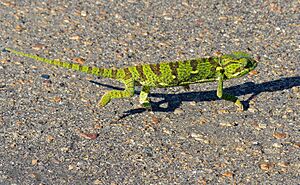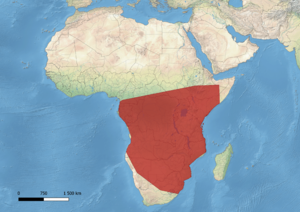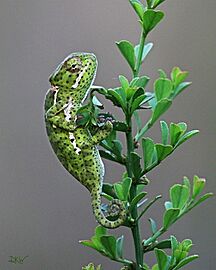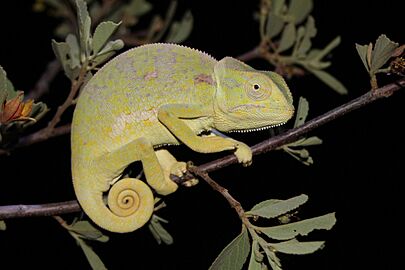Flap-necked chameleon facts for kids
Quick facts for kids Flap-necked chameleon |
|
|---|---|
 |
|
| Kruger National Park, South Africa | |
| Conservation status | |
| Scientific classification | |
| Genus: |
Chamaeleo
|
| Species: |
dilepis
|
 |
|
| Synonyms | |
|
(arranged in alphabetical order)
|
|
The flap-necked chameleon (Chamaeleo dilepis) is a fascinating type of chameleon. It's a lizard that mostly lives in trees, which means it's an arboreal animal. You can find these chameleons in many parts of sub-Saharan Africa.
There are several different kinds, or subspecies, of the flap-necked chameleon. Each one is a slightly different version of the same main species.
Contents
Meet the Flap-necked Chameleon
Different Types of Flap-necked Chameleons
Scientists have found eight different types, or subspecies, of the flap-necked chameleon. Each one has a slightly different scientific name. For example, one type is called Chamaeleo dilepis dilepis.
Why Some Chameleons Have Special Names
Some of these subspecies are named after people. For instance, the roperi subspecies was named to honor G.D. Trevor-Roper. Another one, ruspolii, was named after an Italian explorer named Prince Eugenio Ruspoli.
What Does a Flap-necked Chameleon Look Like?
The flap-necked chameleon is a fairly large chameleon. It can grow to be about 35 centimeters (or 14 inches) long, including its tail.
These chameleons can be many different colors. You might see them in shades of green, yellow, or brown. They usually have a lighter stripe along their lower sides. They also often have one to three lighter patches higher up on their sides.
-
Juvenile female
South Africa
Where Flap-necked Chameleons Live
Their Home Across Africa
Flap-necked chameleons live in a huge area across sub-Saharan Africa. You can find them as far north as Ethiopia and Somalia. They also live as far west as Cameroon and all the way south to northern South Africa.
Their Favorite Places to Live
These chameleons like many different kinds of places. They can live in coastal forests, wet or dry savannahs, and woodlands. They also enjoy bushy grasslands. Sometimes, they even move into areas where people live, like small towns or suburbs.
Life of a Flap-necked Chameleon
What They Eat and Who Eats Them
Adult female flap-necked chameleons dig a hole in the soil to lay their eggs. They can lay anywhere from 10 to 40 eggs at a time. It takes a long time for the eggs to hatch, usually about 10 to 12 months.
Flap-necked chameleons mostly eat invertebrates. These are small creatures without backbones, like crickets, mealworms, and wax worms. Bigger chameleons might even eat small geckos or other chameleons.
But chameleons also have to watch out for predators. Snakes like the boomslang and the twig snake often hunt them.
Flap-necked Chameleons as Pets
Many people enjoy keeping flap-necked chameleons as pets. They are active during the day, which means they are diurnal. If you have one, it's really important to make its home feel like its natural environment.
They can eat crickets, mealworms, and other insects you might catch. These chameleons can live for about 5 to 8 years when cared for properly.
Protecting Flap-necked Chameleons
Are They in Danger?
The flap-necked chameleon is quite popular in the pet trade around the world. It's one of the most traded chameleon species. Over 111,000 of them were sent to other countries between 1977 and 2011, mostly to the USA.
Even with so many being traded, scientists haven't seen a big drop in their total numbers yet. However, they do suggest more studies to make sure the chameleons stay safe. For now, the IUCN (a group that checks on animal populations) lists them as a "Least Concern" species. This means they are not currently considered to be in danger of disappearing.





